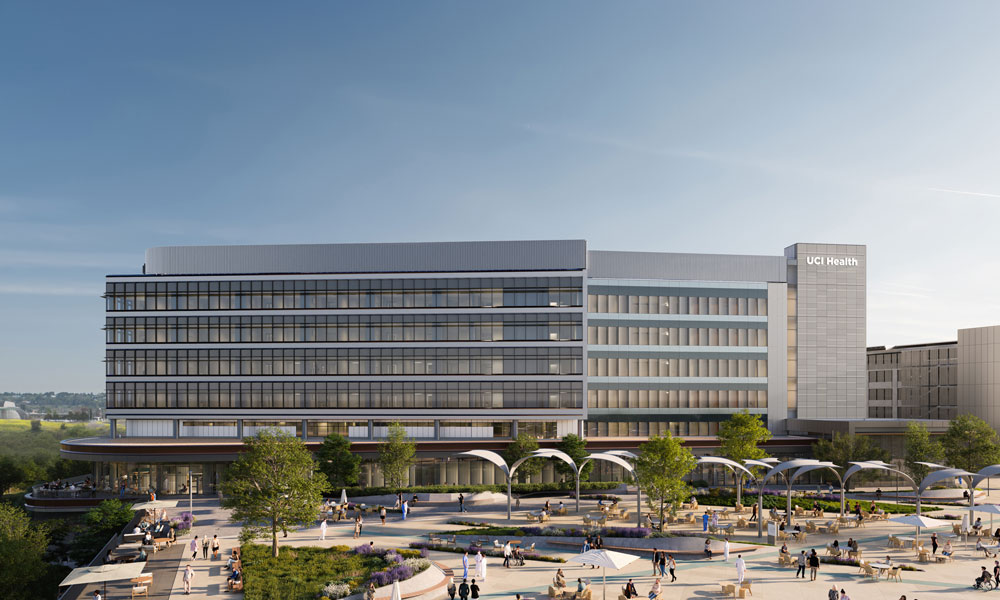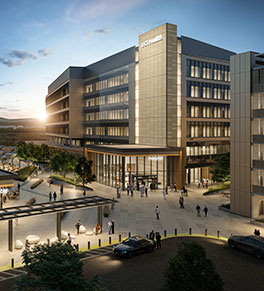
UCI Health — Irvine, the nation's first all-electric acute care hospital, is setting the standard for healthcare sustainability.
Discover the future of hospital care

“Friendly” is not a word typically associated with hospital care. But it quickly became a guiding concept for UCI Health — Irvine, a seven-story, 144-bed all-electric acute care hospital, the nation’s first.
More than five years ago, dozens of UCI Health leaders, staff members and patient advocates came together to envision a new hospital that would overlook the serene, 300-acre San Joaquin Marsh Reserve in Irvine, just north of the UC Irvine campus.
Chad Lefteris, president and chief executive officer of UCI Health, told planners the building should provoke a different feeling than people normally experience entering a hospital, to be a friendly, welcoming place.
“The word reflects Chad’s desire to be the friendliest place to get your healthcare,” says Ellen Khoudari, a senior project manager in UCI Health Planning Administration.
“We want you to feel comfortable here, welcomed, as we would welcome friends to our homes. That’s what we do at UCI Health.”
Setting a new standard
That concept, and so much more about UCI Health — Irvine, defines a hospital that will stand among the most innovative in the country when it opens in December.
Powered by the world-class research of UC Irvine, it is the future of healthcare: technologically advanced, sustainable and designed elements to promote the healing power of nature, says Paul Da Veiga, director of planning, design and construction for UCI Health.
“We know that patients aren’t coming to a hospital because they want to spend a wonderful afternoon here,” Da Veiga says. “People are dealing with serious health issues. But when I give tours of the new hospital under construction, the reaction from many people is, ‘Gosh, I feel like I want to be here or work here.’ This is such a comfortable and friendly environment that folks don’t want to leave.”
Visitors approaching UCI Health — Irvine will find themselves next to a wildlife refuge dotted with riparian trees and flowing native grasses. The arrival plaza has a central sculptural landscape island and clear signage directing patients and visitors. A parking structure directly across from the hospital offers easy access and valet service.
A full-service healing space
Each hospital floor has a purpose. The main level includes a 20-room emergency department (ED) within easy reach of the plaza and parking structure. The ED rooms include fast-track/rapid assessment rooms, regular treatment rooms and a trauma room. To accelerate treatment, an imaging suite with MRIs is adjacent to the ED.
The garden level, which has a separate entrance, is a surgical megafloor that stretches from the hospital to the adjacent outpatient surgery center beneath the new UCI Health Chao Family Comprehensive Cancer Center and Ambulatory Care building. A wholly unique space the width of nearly three football fields, the megafloor will have 18 spacious operating rooms for inpatient and outpatient surgeries.
Infection control is emphasized throughout the hospital with easy-to-clean surfaces and ventilation that exceeds requirements for air turnover, Da Veiga says.
The seventh-floor oncology unit relies on positive air pressure and materials that reduce the risk of infections. The floor is home to the Hematopoietic Stem Cell Transplant and Cellular Therapy Program, the only adult program in Orange County to offer advanced cellular treatments for cancer and other diseases. Even the operating rooms have special air-flow systems to protect the sterile surgical field.
In keeping with the UCI Health emphasis on team-based care, each hospital floor has large rooms where physicians, nurses, social workers, nutritionists, therapists and other caregivers can collaborate, such as when practicing responses to emergency situations.
“Collaboration spaces are very important for care delivery today,” says Dr. Alpesh Amin, associate dean for Clinical Transformation for the UC Irvine School of Medicine and UCI Health.
“How will you move patients through the system? All those things have to occur in a team-based fashion to optimize care.”
The hospital was designed to evoke a feeling of calm and ease for patients, visitors and co-workers, says Josephine Jorge-Reyes, vice president of nursing for the new hospital. Each floor also includes physician on-call rooms, spacious break lounges, flexible workspaces and so-called lavender rooms where co-workers can decompress after stressful experiences.
“These lavender rooms are an important aspect of caring for our healthcare workers,” Jorge-Reyes says. “The complexity of the work requires that people have the ability to take a pause.”
Natural beauty and sustainability
Patients and visitors will feel the healing power of nature throughout the campus, from the marsh views to the outdoor landscaping that includes native plants with medicinal properties and thoughtfully placed gathering spaces.
Many patient rooms have views of the marsh while outdoor terraces offer patients and visitors a place to relax. Outdoor spaces include a dining patio, a meditation garden and walkways to connect the medical campus, including Marsh Edge Trail, which incorporates native coastal sage scrub and riparian species that are also found in the wildlife refuge.
“At the start of the project, we asked, “How can we best utilize the marsh?’ ” says Gina Chang of CO Architects, the company that worked with UCI Health to develop the medical complex. “How can we ensure that patients see it, smell it, interact with it?”
Throughout the hospital, artwork was carefully chosen to feature California Impressionism-style art, primarily of soothing landscapes. A rotating art gallery will feature art reflecting certain events, such as the annual UC Irvine Anti-Cancer Challenge. Patients and visitors can also find solace in an all-faith chapel and meditation garden.
In each space, hospital planners intentionally sought out materials free of chemicals and vapors. Its furnishings, for example, have set a new standard for hospitals, Khoudari says.
Vendors were asked to eliminate the top five most dangerous chemicals from their furniture and produce products that are easy to clean. The vendors, who were required to get a certification to meet the hospital’s safety and sustainability standards, were excited about this challenge.
“We were able to push the market to be more sustainable,” Khoudari says, adding that other medical centers in the state are taking note.
Mindful technology
Behind the natural lighting, serene wall art and environmentally friendly furnishings, the hospital is teeming with the latest technological innovations.
- Sustainability: UCI Health — Irvine represents the future of sustainable architecture. It is the nation’s first all-electric-powered acute care hospital and boasts one of the first all-electric acute care hospital kitchens. When it opens, the hospital is on track to be certified LEED Platinum (the highest level of sustainability certification) — the sixth U.S. hospital to do so. The hospital and its surroundings — including gardens and shaded parking structures topped by solar panels — are designed to reduce solar heat gain by 85%.
- Surgical innovation: Planners took advantage of the megafloor design process to rethink and improve the delivery of surgical care. Digital screens in all operating rooms transform the presurgery patient safety checklist by displaying all relevant information front and center, including name, age, diagnosis and surgical site. The screens can also display any relevant imaging as well as calming scenes for patients and team members. Software sends patient updates to visitors via monitors.
- Digital records: The hospital will implement a “digital first” approach to recordkeeping, using the Epic electronic medical records system, says UCI Health Chief Medical Information Officer Dr. Deepti Pandita. Patients can use mobile devices to check wait times when they enter the ED or to assess their status, including the discharge process, while hospitalized. Digital signage will also be visible outside patient rooms.
- Imaging: MRI placement in the hospital also has been reimagined. Instead of the standard basement location, two MRIs will be located on the second floor next to the ED. One is a highly advanced 3T machine while a second machine integrates the latest in artificial intelligence. Normally mounted on a slab, these devices will "float" via a specially made system to reduce noise and vibration.
- Interactive patient care: The hospital will have a voice-over/internet communication platform, allowing a doctor to relay orders from their mobile device directly to nurses in the patient’s room using a video call or connecting with a patient’s electronic chart.
“Physicians are never tied to one place,” Pandita says. “They’re rounding, operating, seeing patients. Having that mobile-first strategy is going to be a game changer by saving time and elevating patient care.”
- Nurses will be able to consult with a counterpart in another location via the patient’s television. Faraway loved ones can connect with a patient in their room as well.
“If you want to bring in family members who may be across the country or the world, we can set up video calls to discuss the patient’s care or progress,” Pandita says.
The hospital will eventually have 360° ambient cameras to confidentially document clinician conversations and help co-workers identify patients at risk of falling or slipping out of bed. Other remote monitoring programs are being implemented within the hospital, including in the cardiac and epilepsy units.
“We will have someone watching over a monitor in another location who can intervene over a two-way camera and speaker system if needed,” says Jorge-Reyes.“It’s like having another set of eyes.”
Community synergy
The hospital is the third and final building to open on the medical complex, a place where coastal and south Orange County residents can meet all their healthcare needs without spending hours in traffic.
The first two buildings opened last year: the Joe C. Wen & Family Center for Advanced Care and the Chao Family Comprehensive Cancer Center and Ambulatory Care building.
In the future, UC Irvine leaders hope to connect the university and medical campuses with a bucolic walking trail that would skirt the San Joaquin Marsh Reserve.
Proximity to the university is already infusing the medical campus with an air of innovation, energy and hope for the future, says Da Veiga.
“When you’re on the medical campus, you can feel our philosophy of care: Discover. Teach. Heal. The teaching and discovering is happening just half a mile away, and all that will be brought to our hospital to heal our patients.”
Discover more about UCI Health — Irvine
Related stories
- Inpatient menu unveiled for taste test ›
- 'Megalfoor' to transform surgical efficiency, quality ›
- State-of-the art MRI scanners hoisted into place ›
- A dream come true in Irvine ›




